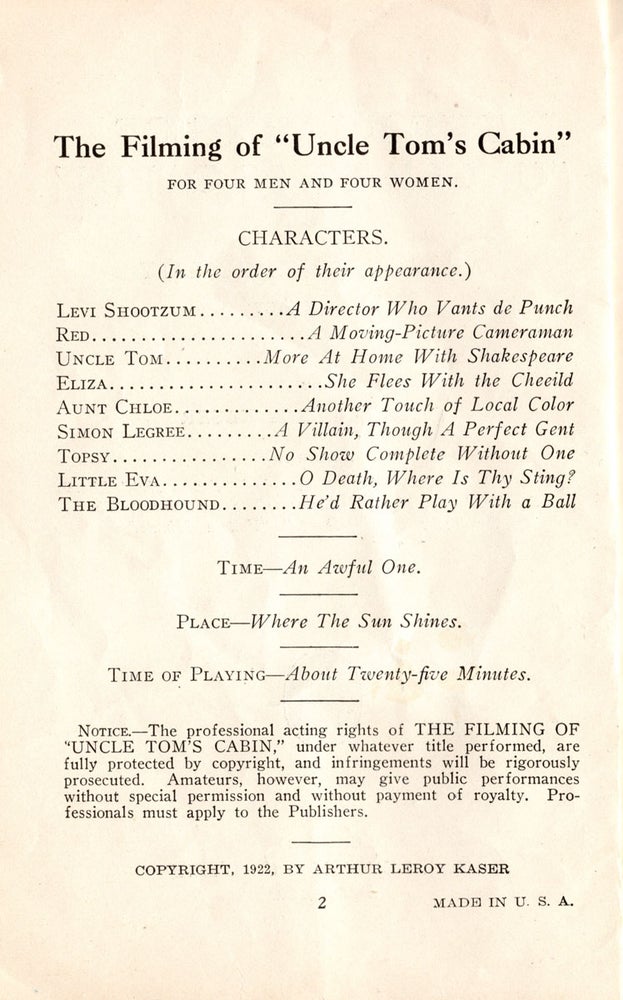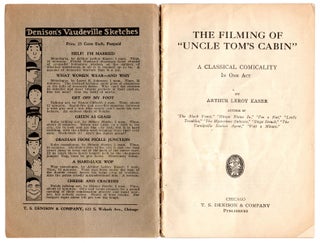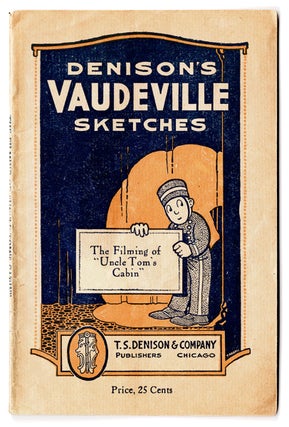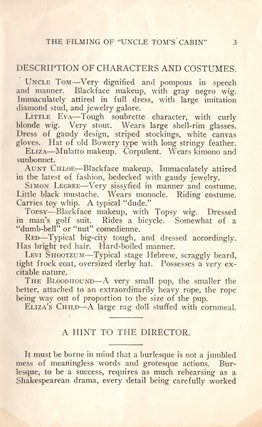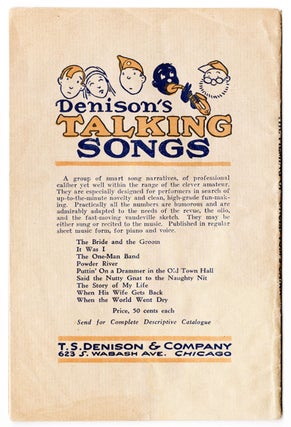The Filming of “Uncle Tom's Cabin.” A Classical Comicality in One Act.
Chicago: T. S. Denison & Company, 1922. Small 8vo (7.125” x 4.75”), light brown pictorial wrappers printed in blue and orange, 15 pp. CONDITION: Very good, slight discoloration to last two leaves and back wrapper; glue showing at hinges (text block solidly attached). First edition of this early work by a prolific and popular vaudeville writer of the Jim Crow era, in which Jewish director Levi Shootzum attempts to film a stage production of Uncle Tom’s Cabin. Part of T.S. Denison & Company’s “Vaudeville Sketches” series and among just three scripts that Arthur LeRoy Kaser published in 1922, this farcical tale was written in the first two years of Kaser’s prolific publishing career. The script exploits multiple layers of “Uncle Tom” stage clichés by mixing them with other stereotypes of the Jazz Age: the shallowness of Hollywood glamor, the alienating effects of technology, and the inept and “excitable” Jew. Its dialog offers numerous opportunities for amateur troupes to localize their performance, and helped establish Kaser’s easy-to-direct and malleable signature style: EVA. Oh Mister Shootzum, when do I go to Heaven? Along with lists of characters and props, Kaser offers a “Hint to the Director” about the importance of thorough preparation and serious performance. The last thing a troupe should do is fumble its lines or “convey to the audience that you are trying to make them laugh.” The script describes Uncle Tom—or rather, the actor playing him—as “pompous in speech and manner” and wearing “jewelry galore,” while Little Eva is “Tough” and “Very stout,” which makes her fellow actors’ attempts to hoist her up “to Heaven” by a rope very difficult indeed. Legree, who in Stowe’s novel whips Tom to death, is described as “Very sissified,” and the director is a “Typical stage Hebrew” with “a very excitable nature.” The sketch ends when the Irish-American cameraman accidentally blows up the machine, startling the cast into dropping Eva in the midst of her long-awaited ascension. Arthur LeRoy Kaser (1890–1956) grew up in La Porte, Indiana, where he became enamored with the vaudeville acts that passed through town. Able to mimic a variety of immigrant accents, he began putting on amateur performances in his teens, and after several menial jobs and a stint in the Army during World War I, he started publishing his own scripts. By 1924 he was writing full time, and by the late 1920s was producing 1,500 pages of material each year under at least sixty pen names. Easygoing, prolific, and fast, Kaser was a favorite among publishers. One Boston publisher is said to have “described a book he needed and asked Kaser if he would like to write it. Kaser replied, ‘I believe I would.... Where’s a typewriter’” (Drew, p. 165). In 1929, Kaser described his scripts as “a salvation for the many amateur minstrel troupes which lack the personal counsel and guidance of an experienced director. Thoroughly professional in style, yet entirely practical for amateurs and give big opportunity for localized jokes” (Drew p. 166). Kaser’s production declined during the 1930s and ‘40s, but his plays were widely produced in amateur settings across the U.S., and held a significant and problematic place for minstrelsy and amateur performance during the Jim Crow and Jazz ages. REFERENCES: Drew, Bernard A. Black Stereotypes in Popular Series Fiction, 1851–1955 (Jefferson, NC: McFarland, 2015).
LEVI. Shust a minute. But vhy de rushness?
EVA (shyly). There is a man going there that I want to see.
LEVI. Who iss de man?
EVA (shyly). It is—(name well-known local politician).
Item #7371
Price: $375.00


